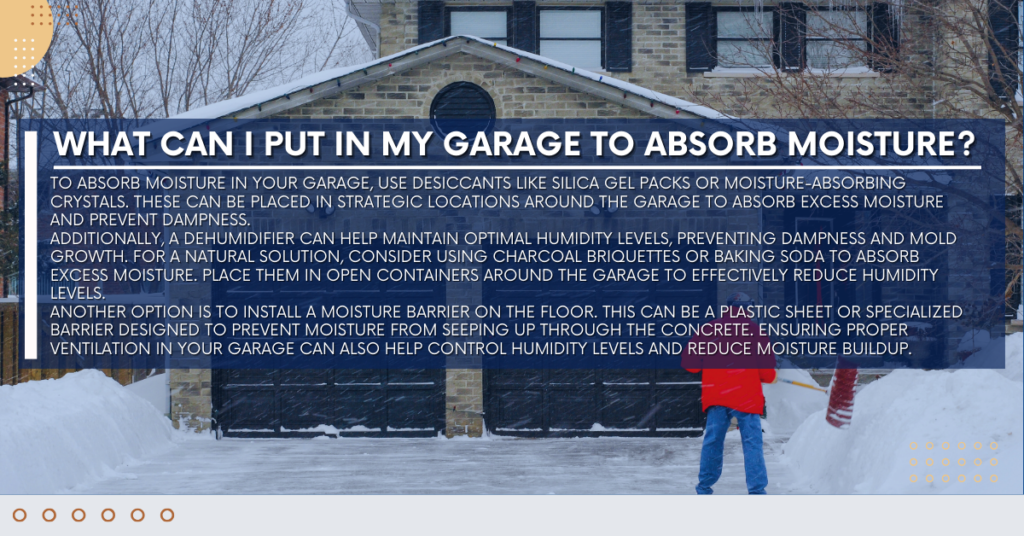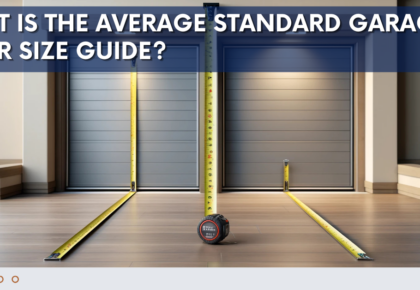How do I keep water out of my garage when it rains?
Water entering your garage during rains can cause significant damage, including mold growth, structural issues, and damage to stored items. To prevent this, start by inspecting the structure for any gaps or cracks, especially around doors and windows. These gaps can be sealed with weather-resistant caulk to create a barrier against water.
Installing a rubber door sweep at the bottom of your garage door is another effective measure. The sweep blocks water from entering underneath the door. Additionally, ensure the ground outside your garage slopes away from the building to prevent water from pooling near the entrance. You might also consider installing a trench drain in front of the garage to capture and redirect water away from the building.
How to weatherproof your garage?
Weatherproofing your garage involves several steps to ensure it is protected against rain and moisture. First, apply a waterproof sealant to the floors and walls. This creates a barrier that prevents water from seeping through the concrete.
Next, ensure your garage door has a tight seal. Replace any worn-out weatherstripping around the door and consider installing a threshold seal. A threshold seal is a raised barrier at the bottom of the door that blocks water from entering. Additionally, insulate your garage walls and ceiling to keep the temperature stable and reduce the risk of condensation, which can lead to moisture problems.
Investing in high-quality windows with weatherproof seals can also help prevent water from entering through window frames. Lastly, check your garage roof for any signs of leaks and repair them promptly to prevent water damage.
How do I protect my garage door from rain?
Protecting your garage door from rain is essential to maintaining the integrity of your garage. Start by inspecting the weatherstripping around the door. Weatherstripping helps to create a seal that blocks water and air from entering. If it’s damaged or worn out, replace it with new weatherstripping to ensure a tight seal.
Consider adding a door canopy to deflect rain away from the door. This simple addition can prevent water from hitting the door directly and reduce the amount of moisture that enters the garage. Additionally, applying a water-repellent coating to the door can provide an extra layer of protection against rain.
For added security, check the door’s alignment and ensure it closes tightly without gaps. If your garage door is made of metal, inspect it regularly for signs of rust and treat any affected areas promptly to prevent further damage.
How to block cold air from garage door?
Blocking cold air from entering your garage door involves improving insulation and sealing any gaps. Start by installing a garage door insulation kit, which includes panels that fit into the door’s frame. These panels can significantly reduce heat loss and keep your garage warmer during cold weather.
Additionally, check the weatherstripping around the door and replace it if needed. Weatherstripping helps to seal gaps and prevent cold air from entering. Installing a threshold seal at the bottom of the door can also help keep cold air out.
For further insulation, consider insulating the walls and ceiling of your garage. This will help to maintain a stable temperature and reduce the amount of cold air that enters. If your garage has windows, use insulated curtains or window films to improve their thermal efficiency.
What can I put in my garage to absorb moisture?

To absorb moisture in your garage, use desiccants like silica gel packs or moisture-absorbing crystals. These can be placed in strategic locations around the garage to absorb excess moisture and prevent dampness.
Additionally, a dehumidifier can help maintain optimal humidity levels, preventing dampness and mold growth. For a natural solution, consider using charcoal briquettes or baking soda to absorb excess moisture. Place them in open containers around the garage to effectively reduce humidity levels.
Another option is to install a moisture barrier on the floor. This can be a plastic sheet or specialized barrier designed to prevent moisture from seeping up through the concrete. Ensuring proper ventilation in your garage can also help control humidity levels and reduce moisture buildup.
Is it OK to leave water in the garage?
Leaving water in your garage is not advisable. Standing water can lead to mold growth, structural damage, and create a breeding ground for pests. It’s best to address water issues immediately and ensure your garage is dry and well-ventilated.
Use a mop or wet vacuum to remove standing water and ensure proper drainage to prevent future accumulation. Regularly inspect your garage for signs of leaks or water intrusion and address any issues promptly to maintain a dry and safe environment.
Ensuring your garage is properly sealed and has adequate drainage can prevent water from accumulating. If your garage is prone to flooding, consider installing a sump pump to manage excess water and keep your garage dry.
What can I put on my garage door to keep water out?
To keep water out of your garage door, consider installing a door threshold seal. This acts as a barrier against water intrusion by creating a raised edge that prevents water from entering under the door.
Additionally, applying a waterproof sealant around the door frame can prevent leaks. Regularly inspect and replace weatherstripping to ensure it remains effective in blocking water. Installing a door canopy can also help by deflecting rain away from the door, reducing the amount of water that reaches it.
For added protection, consider using a waterproof paint or coating on the exterior of your garage door. This can help to repel water and reduce the risk of damage from prolonged exposure to moisture.
What is the best way to waterproof a garage?
The best way to waterproof a garage involves several steps. Start by sealing any cracks in the walls and floor with epoxy or a similar sealant. Cracks can allow water to seep through, so sealing them is crucial to prevent leaks.
Apply a waterproof coating to the floor and walls to create a barrier that prevents water from penetrating the concrete. Ensure proper drainage around the garage by installing gutters and downspouts that direct water away from the structure.
Consider installing a sump pump if your garage is prone to flooding. A sump pump can help to remove excess water and keep your garage dry. Additionally, installing a French drain or trench drain around the perimeter of the garage can help to collect and redirect water away from the building.
Why is my garage flooding when it rains?
If your garage floods when it rains, it could be due to poor drainage, cracks in the foundation, or an improperly sealed door. Inspect the perimeter of your garage for any signs of water pooling and address drainage issues promptly.
Sealing cracks in the foundation and ensuring your garage door is properly sealed can also help prevent flooding. Check the grading around your garage to ensure water flows away from the structure. If the ground slopes towards your garage, consider regrading the area or installing a drainage system to redirect water.
Regular maintenance of gutters and downspouts is also essential to prevent water from overflowing and causing flooding. Ensure they are clear of debris and functioning properly to direct water away from your garage.
How do I ventilate my garage?
Proper ventilation in your garage is crucial to prevent moisture buildup and improve air quality. Install vents or exhaust fans to facilitate airflow. Keeping windows open when weather permits can also help ventilate the space.
Additionally, using a dehumidifier can control humidity levels. Proper ventilation reduces the risk of mold and mildew, keeping your garage environment healthy. If your garage is attached to your home, consider installing a vent that connects to your home’s HVAC system to improve airflow.
Another option is to install a louvered vent on the garage door. This allows for continuous airflow while keeping the door secure. Proper ventilation not only helps to control moisture but also improves the overall air quality in your garage.
Why is my garage pooling water when it rains?
Water pooling in your garage can result from poor drainage systems, uneven flooring, or clogged gutters. Ensure your garage floor has a slight slope directing water to a drainage point. Regularly clean gutters and downspouts to prevent water overflow.
Installing trench drains around your garage can also help direct water away from the building. If your garage floor is uneven, consider resurfacing it to create a proper slope for drainage. Additionally, check for any low spots around your garage that might collect water and address them by regrading the area or installing drainage solutions.
How do I divert water from my garage?
To divert water from your garage, install a French drain or a trench drain around the perimeter. These drains collect and redirect water away from your garage. Ensure your gutters and downspouts are clear and direct water away from the foundation.
Landscaping can also help; create swales or berms to channel water away from your garage. Adding gravel or other permeable materials around the perimeter can also help improve drainage and prevent water from pooling near your garage.
Consider installing rain barrels to collect runoff from your roof. This not only helps to manage water flow but also provides a sustainable source of water for gardening and other uses.
How do I stop water from coming through my garage concrete floor?
Water can seep through a concrete floor if it’s not properly sealed. Apply a high-quality concrete waterproofing sealant to create a barrier. Additionally, check for any cracks in the floor and seal them with an appropriate filler to prevent water ingress.
Ensure your garage has proper drainage and consider installing a sump pump if necessary to manage water flow. Regular maintenance and inspection of your garage floor can help to identify and address any potential issues before they become major problems.
How to improve garage drainage?
Improving garage drainage is essential to prevent water buildup and flooding. Start by ensuring that your garage floor has a proper slope towards a drainage point. This can be achieved by resurfacing the floor or installing a drain.
Installing a French drain or trench drain around the perimeter of the garage can help to collect and redirect water away from the building. Ensure that gutters and downspouts are functioning properly and directing water away from the garage foundation. Regularly clean these systems to prevent clogs and overflow.
Landscaping can also play a role in improving drainage. Use gravel or other permeable materials around the garage to allow water to seep into the ground rather than pooling on the surface. Creating swales or berms in your yard can also help to channel water away from your garage.
Protecting items stored in the garage from moisture
Moisture can damage items stored in your garage, so it’s important to take steps to protect them. Start by storing items off the floor. Use shelves or pallets to keep boxes and other items elevated, reducing the risk of water damage.
Use airtight plastic bins for storage instead of cardboard boxes. Plastic bins provide a barrier against moisture and pests. Additionally, consider using moisture-absorbing products like silica gel packs or moisture-absorbing crystals inside storage containers to keep the contents dry.
Ensure proper ventilation in your garage to reduce humidity levels and prevent mold growth. Using a dehumidifier can help to maintain optimal humidity levels. Regularly inspect stored items for any signs of moisture or mold and address any issues promptly.
Maintaining your garage during the rainy season
Regular maintenance is key to keeping your garage in good condition during the rainy season. Start by inspecting the garage structure, including the roof, walls, and foundation, for any signs of leaks or damage. Repair any issues promptly to prevent water intrusion.
Check the weatherstripping and seals around doors and windows and replace them if they are worn or damaged. Ensure that gutters and downspouts are clean and directing water away from the garage foundation. Regularly clean these systems to prevent clogs.
Keep your garage well-ventilated to reduce humidity levels and prevent mold growth. Use fans or dehumidifiers to maintain optimal humidity levels. Additionally, inspect stored items regularly for any signs of moisture or mold and take steps to protect them from water damage.
Final thoughts
Preparing your garage for the rainy season involves a combination of preventive measures and regular maintenance. By sealing gaps, improving insulation, ensuring proper drainage, and using moisture-absorbing products, you can protect your garage and its contents from water damage. Regular inspections and prompt repairs are essential to maintaining a dry and functional garage. Taking these steps will not only protect your property but also extend the lifespan of your garage, keeping it safe and usable for years to come.








